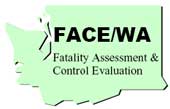Maintenance Worker Killed When Struck by a Vehicle Along a Highway in Washington State
Washington Case Report 02WA048
Release Date: October 23, 2006
Summary
On August 12, 2002, a 50-year-old maintenance technician died when he was struck by a pick-up truck along a major state highway in Washington State. A maintenance work crew, consisting of two people, was in the process of loading a tractor with a mower attachment onto a trailer when the incident occurred. The driver of the pick-up truck was traveling east along the divided highway, when he suddenly swerved off the road and struck the victim. The co-worker was also struck by the impact and suffered a leg injury in the incident. The co-worker was on the opposite side of the trailer and not as exposed to traffic hazards as the victim. Witnesses called 911 within moments to attend to the victim, but he died at the scene.
To prevent similar occurrences in the future, the Washington State Fatality Assessment & Control Evaluation (FACE) investigative team concluded that employers engaged in roadway construction or maintenance should follow these guidelines:
- Re-engineer the equipment load-binder/safety chain system on the trailer so that workers are able to secure equipment without having to stand near the traffic-side of the trailer.
- Strategically load and unload equipment onto trailers in areas with no traffic exposure. Use distance or existing protection such as highway guardrails for added protection.
- Use a protection vehicle in a blocking position to act as a barrier for workers in a work zone, in the event that an errant vehicle enters the working area.
- Employers and employees should identify appropriate escape routes for workers in the event that a vehicle does not follow intended traffic controls or expected driving norms.
Introduction
In August of 2002, the Washington State FACE Program was notified by the WISHA* (Washington Industrial Safety & Health Act) Services Division (now called Division of Occupational Safety and Health, or DOSH) of the death of a 50-year-old maintenance technician.
The Washington FACE Field Investigator met with the regional WISHA representative who was investigating the case. After reviewing the case with WISHA, the WA FACE team traveled with the WISHA representative to the incident site. The WISHA representative helped locate the site of the incident, define the details of the work site, and the position of the people and equipment involved in this incident. The Washington FACE Field Investigator also met with representatives of the maintenance technician’s employer involved in this incident.
The incident site was located along a major highway in Washington State. A work crew, which consisted of two people (the victim and a co-worker), were in the process of cutting grass and vegetation off the shoulder and along the sides of the road.
The road, situated along the “incident area”, was a four-lane divided state highway that runs east and west through a section of western Washington. The asphalt highway is a major roadway that carries consistent and fairly heavy traffic flow throughout the day.
The incident area along this section of the highway was essentially a controlled access corridor so there were no intersecting streets along this road to impact the highway near the maintenance work zone. There was a highway exit several hundred feet further up (east) from the incident work site.
The maintenance work team was mowing the south section of highway vegetation just off the shoulder of the road prior to the incident. After mowing for a short time, the victim experienced a problem with the mower. He informed his co-worker of the problem, and they returned to their maintenance facility hoping to get a replacement part to fix the mower.
After lunch and discovering that the maintenance shop would need the mower for the repairs, the two returned to the work site and began the process of loading and securing the tractor and mower onto their trailer in order to transport it back to their maintenance facility. They had their maintenance vehicle (dump-truck) and attached trailer, which was used to tow the tractor and mower, parked along the paved shoulder of the highway.
The posted speed limit for this section of the highway was 60 mph. The weather that day was clear, dry and warm and was not considered a factor in the incident. The employer in this incident has a history that goes back almost one-hundred years and has incorporated a varied list of highway and transportation operations in its long history. The organization employs about 6,000 people who work in various departments and functions and locations throughout the state.
It was determined that the employer had a very good safety program in place, which was based on the review by the FACE Field Investigator. The employer had a full time central office safety & health administrator and several regional safety people. The employer had a comprehensive, written accident prevention program. The employer also had several very active health and safety committees, which included a work zone safety committee that meets either on a monthly basis or periodically as needed. They also conducted “tool box” meetings regularly with work team members to discuss safety and health issues.
The employer conducted routine safety training for their employees that included training in highway and work zone hazards. They certified their own flaggers and much of the highway safety training and re-training came from the flagger and supervisor certification process. The employer did not have a specific traffic control plan for the incident work zone site, but it was determined the work area process followed accepted practice and WSDOT and MUTCD guidelines.
The victim, at the time of the incident, was working as part of a two-person crew on a mid-summer mowing and roadside vegetation maintenance assignment. The victim had worked for the employer for a little over 24 years and had almost an equal amount of experience and knowledge of the hazards of highway and roadside maintenance work. His primary job was working as a maintenance technician which entailed a variety of duties such as physical roadway maintenance, mowing and managing roadside vegetation, and occasional flagging duties as needed.
On a sunny August afternoon at approximately 1:30 PM, the victim was struck and killed by the driver of a pick-up truck traveling erratically down the highway. The victim was in the process of securing the trailer tie-downs for the tractor on the traffic-side of a flatbed trailer parked on the shoulder of the highway. The driver of the pick-up was a 54-year-old male, who was driving after taking a large quantity of the prescription narcotic drug oxycontin. The driver was convicted of vehicular homicide while driving under the influence.
* The OSHA State Plan program in Washington State.
Back to Top
Investigation
On Monday morning, August 12, 2002, the victim and co-worker started out at their maintenance facility at about 7:00 AM by planning their day’s activity. They began the day with a short meeting with their supervisor to discuss the highway roadside vegetation control and mowing that was to been done that morning.
The maintenance group normally would review areas and develop an operations plan for work-specific priorities such as maintaining control of vegetation along roads and highways. That morning they would be working along a high speed (60 mph) multi-lane state highway in western Washington.
They got into their work vehicle, a dump truck with an attached utility trailer carrying a tractor with mower attachment secured to the trailer deck. Sometime between 7:30 AM and 7:45 AM they started out for the first mowing site. At about 8:30 AM they arrived at the site, and picked a spot to park the vehicle and trailer.
They chose a parking spot that was level so that they could unload the mower and that had good visibility to be seen by the traffic flow traveling past that area. The two workers placed four orange traffic cones along the shoulder and also had the flashing arrow/message board on their dump truck activated along with the truck’s flashing lights to help warn traffic of their vehicle and trailer, and the work zone located just off the shoulder of the highway.
They unlatched the binders that secured the mower to the trailer and unloaded the tractor/mower. The workers then moved the truck up onto a bank along the side of the road, so they would be out of the way, and unhooked the trailer from the truck. The victim then started mowing the selected area along the highway.
After mowing for about 10 minutes, a drive-belt broke on the mower. The victim radioed his co-worker about the problem. The co-worker drove the truck and trailer to where the mower was now located. The victim reviewed the mower problem with the co-worker and they decided to get a replacement part for the mower. The two workers got into the truck and headed back to their maintenance facility.
They reviewed the problem with a facility mechanic, and it was determined that they could not fix the mower without bringing the mower back into the shop. The victim and the co-worker decided to have lunch at the maintenance facility before they traveled back to the mowing site to pick up the tractor/mower. After lunch, the victim and the co-worker headed back to the work site to pick up the mower and return it back to the maintenance facility for repair.
They arrived back at the work-site and parked the dump truck along the same area of the highway and re-set up cones along the shoulder of the road. The flashing arrow board on the truck was also again activated to warn motoring traffic of the work zone.
Their truck and trailer were parked primarily off on the asphalt shoulder of the highway. Part of the passenger-side trailer wheels, were on the grassy edge of the shoulder. The grassy area was level, and firm, with light vegetation which transitioned into the asphalt shoulder with no significant drop off. The area was easily able to support the weight of the truck and trailer plus that of the tractor/mower without any issues. (See photo 4)
The truck and trailer were positioned facing east along the highway. The co-worker prepared the tilt-up trailer getting it ready to load the tractor/mower while the victim went to get the tractor. The victim drove the tractor onto the trailer and prepared to help the co-worker secure the tractor to the trailer.
Just prior to the process of the victim and co-worker loading the tractor/mower onto the trailer, another scenario was taking place along a nearby highway. A red pick-up truck was traveling along a two-lane blacktop road that travels north and south, and intersects the incident site highway. At the same time that this red pick-up was moving down this secondary road, two passengers in another vehicle, traveling in the same direction as the red pick-up truck, witnessed this pick-up truck traveling erratically. They saw the vehicle swerve into the on-coming lane and then turn back toward to the shoulder of the traveled lane several times. They followed the red pick-up, honking their horn to get the driver’s attention.
They did not have a cell phone or otherwise they might have called 911 to alert authorities of this potential hazardous driver. As they were following the pick-up, the driver swerved off the road striking a guardrail with its right front quarter panel; but this incident didn’t seem to affect the driver at all, as he kept on going down the road at speeds between 10 mph and 55 mph. Then, it appeared that the red pick-up truck was about to turn left onto the on-ramp leading east to the multi-lane highway and in the direction of the maintenance work zone.
After the driver had entered the left turn lane, he suddenly stopped for no apparent reason. There was no on-coming traffic that would have prevented the pick-up truck driver from making the left turn onto the highway on-ramp. It was at this point that one of the persons from the passenger vehicle took the opportunity to get out of their vehicle and see if the driver was alright. They wanted to talk to the driver and to see if they could try to get him to stop driving and/or to get him some help.
They weren’t sure if the driver was having some kind of medical problem, or if he was driving were under the influence. They were not sure if he needed help, but they wanted to help this driver, and have him get off the road until other help arrived. The person talked to the driver of the pick-up, who was described as seemingly confused and his eyes were glassy. The pick-up truck driver insisted that he was fine and could drive with no problem.
At about the same time, two other co-workers of the victim were traveling in the same vicinity but in the opposite direction of the red pick-up truck and the other passenger vehicle along this secondary two-lane road. They saw the passenger vehicle stopped behind the red pick-up truck at the highway left turn lane. One of the passengers seemed be talking to the driver of the pick-up in a very stressed, animated way. They turned their vehicle around to see if there was a problem and to see if they could be of help. Just as they pulled to a stop behind the passenger vehicle, the red pick-up truck drove off onto the on-ramp of the multi-lane highway and headed east toward the work zone where the victim was working.
The person from the passenger vehicle tried to flag down other vehicles passing by when they saw the victim’s co-workers pull up behind them. The individual franticly rushed over to talk with the co-workers to express his concern over the pick-up truck driver’s erratic behavior on the road. The co-workers told the passenger vehicle occupants that they would call 911 about their concerns and that they would try to track down the driver to see if they could get the driver’s attention and try to get him off the highway.
The two co-workers drove their vehicle down the highway on-ramp, trying to intercept the erratic pick-up truck driver, and simultaneously they called 911 to alert authorities of the situation. They quickly caught up with the red pick-up truck. While they were following the vehicle, they also witnessed a possible problem with the driver of the pick-up truck about two miles from the work zone location.
They saw the pick-up truck driver slowing down and then speed up as he traveled east on the highway. They observed him almost loose control when he drove to the right shoulder of the road. The red pick-up drove back into the right lane of travel and then headed into a downhill section of the road. The red pick-up driver continued to speed up then slow down as part of his observed driving pattern traveling down the highway.
As the co-workers got to the downhill section of the highway in their vehicle, they spotted the work zone to the right-hand side of the road, just off on the shoulder on the south side of the highway. The victim and the co-worker had just loaded the tractor and mower onto their trailer and were in the process of locking down the axle-binders that were in place to secure the tractor/mower to the trailer, so that it could be safely transported to the maintenance facility.
The victim was working on engaging the left side of the tractor/trailer binders while standing near the highway traffic side of the road. The co-worker was on the opposite side of the trailer working the right tractor/trailer binders. The driver of the co-workers’ vehicle honked his horn to get the attention of the two men who were working along the shoulder of the road, and to alert them of the errant vehicle heading their way.
It was about 1:30 in the afternoon when suddenly the red pick-up truck swerved to the right and drove about three feet off the road onto the right shoulder of the road. The victim had just finished securing the tractor onto the trailer and was standing at the left rear of the trailer talking to his co-worker. The co-worker was anxious about the victim standing near the traffic side of the road and told him to hurry up and get to where it was “safe” on the other side of the trailer. The victim jokingly responded by saying that they were highway maintenance workers and they would not get hit as they were “exempt.”
At about that moment, the red pick-up truck drove through the traffic cones that were placed as warning devices for the work zone in advance of the dump truck and trailer along the highway. Next there was a violent collision with the red pick-up truck striking the victim and the side of the trailer. The victim died almost instantly from the impact.
The co-worker was knocked backwards several feet by the impact with the trailer. He suffered a leg injury. The pick-up truck flipped upside-down landing on its top after striking the victim and trailer. The pick-up ended stopped resting on its roof, blocking the two eastbound lanes of the highway.
The co-workers, who were following the red pick-up, witnessed this incident involving their fellow workers. They quickly pulled their vehicle to a stop, and rushed to help the injured workers. They determined that the first worker had died immediately upon impact by the pick-up truck, so they focused their attention on the second worker. Several people who witnessed the incident placed calls to 911.
After assessing the injured workers’ condition, one of the co-workers stayed with the injured associate while the other went to check on the driver of the pick-up truck who was in the overturned truck. Another motorist who had witnessed the incident was already attending to the pick-up truck driver, so the co-worker went to help manage traffic that was trying to travel past the incident site.
The pick-up truck driver was trapped in the truck until help arrived. When paramedic units and the Washington State Patrol arrived at the scene, they noted that the victim was dead at the scene and had probably died on impact with the pick-up truck. They attended to the co-worker’s injuries, and extracted the driver of the red pick-up truck from his vehicle.
The east bound lanes were shut down for several hours as emergency crews attended to the victims and also while the Washington State Patrol conducted their investigation of the incident. Paramedics, during their medical/injury patient assessment, found several pills in the pick-up truck driver’s socks that were identified as oxycontin, a prescription narcotic drug. The pick-up truck driver was convicted of vehicular homicide while driving under the influence.
Cause of Death
The medical examiner listed the cause of death as multiple skull and skeletal factures, transection of the thoracic spinal cord and aorta, and amputation of lower extremities due to, or as a consequence of a pedestrian being struck by a motor vehicle/truck.
Recommendations/Discussion
Recommendation #1: Re-engineer the equipment load-binder/safety chain system on the trailer so that workers are able to secure equipment without having to stand near the traffic-side of the trailer.
Discussion: The victim in this incident was fatally injured when a vehicle struck the victim while he was securing a tractor onto a utility trailer. The victim was standing on north side (the driver’s side) of the utility trailer which was situated along the shoulder of the highway but was exposed to the fast moving (60 mph +) traffic traveling past the work-site. Both the victim and the co-worker were focused on securing the tractor/mower to the trailer using the trailer’s load binder/safety chain system. They had just finished securing the front of the tractor and were working on the back section when the impaired driver traveled off the road and struck the victim.
It is recommended that the load-binder/safety chain system be reviewed in order to look at the possibly of the system being re-designed or installation of a new system to help minimize worker exposure to traffic while loading equipment along roadways. The employer should check with the utility trailer manufacturer or distributor to see what equipment securing devices are available for upgrade or changes that can be made to upgrade the system.
The manufacturer may not have anything available that they manufacture or use to upgrade the system, but they may know of an aftermarket system that might be available for use on the utility trailer. If there are no other known options that are available, then the manufacturer might still be able to help with recommendations on how the employer might be able to upgrade/re-engineer the system themselves.
It is important though, that the employer check with the utility trailer manufacturer/distributor prior to taking on the task of re-designing the load-binder/safety chain system, in order to make sure that any proposed re-design is structurally compatible with the trailer design and use.
Consider using a system that would not require any immediate manual handling in its operation, and thus perhaps be a more efficient system such as one that has an automatic attachment mechanism. An automatic system would secure the machine by surrounding and anchoring the wheels of the mower or other wheeled equipment once it is in place on the platform. Look for a system that would allow the individual to drive onto the trailer directly and onto the securing device on the trailer that would then lock the tractor onto the trailer for safe transport.
Temporary work zones present constantly changing conditions for the traveling motorist and for the workers in the work zone. These changing conditions often can cause confusion and distractions that can result in the drivers reacting differently to each work zone or highway situation.
Driving while distracted (i.e., using cell phones), aggressive drivers, and persons under the influence of legal or illegal drugs or alcohol can tragically affect a person’s ability to safely drive past a work zone. It has been noted in many studies, that approximately 25% or more of all drivers who are on the road at any one time, fit into this category. Because a highway work zone can have multiple risks for the driver and the worker, it is equally as important that the work zone be as safe as possible for both the worker as it is for the road user.
History has shown that working along roads and highways can be a dangerous place for the worker on foot. Reducing the worker exposure to vehicle traffic, especially in high volume and high speed highways, roadways and specific traffic corridors, can literally be a mater of life and death. Re-engineering or replacing the load-binder/safety chain system could eliminate having a person stand along the traffic-exposed side of the trailer and thus reduce the possibility of the person being injured or killed by an errant vehicle driving into the work zone.
Recommendation #2: Strategically load and unload equipment onto trailers in areas with no traffic exposure. Use distance or existing protection such as highway guardrails for added protection.
Discussion: Whenever setting up a work zone or work site, the employers and employees need to consider all possible safeguards that will provide the best protection for workers within the work zone. One of those considerations should be establishing safe positioning and parking practices for staging equipment and materials, and for working near moving traffic along roads and highways.
At every work zone, personnel have serious risks and exposures from motorists driving past the work zone. One should never trust that vehicles will travel in expected travel lanes due to a variety of distractions and influences that affect their driving along roads and highways. One should review the work site for the absolute safest place to park and unload machines and equipment, and one that provides the best protection for the personnel doing the unloading.
If there are existing guard rails and/or crash cushions and there is adequate and reasonably level terrain to safely park vehicles, take a look at the ability to be able to park and locate the vehicle/trailer behind these existing devices to provide protection for loading and unloading equipment. If there are no guardrails, or crash cushions available in the area, then take a look at some of the natural topography of the work area that can provide a degree of protection for the workers on foot. Though perhaps not as effective as engineered guardrails, sometimes the natural topography can provide adequate protection when other protection modes are not available.
Another option, if this is available, is to use sufficient distance from the hazard. The hazard in this case is the motoring traffic on a high-speed, multi-lane highway. The use of distance in many cases can help buffer the hazard, such as an errant vehicle that enters the work zone. Distance often can provide enough time and space for an errant vehicle to recover without causing problems within the work zone to the driver or for the workers. Distance might also provide adequate warning for workers of an errant vehicle so that the workers can take appropriate evasive action by using their established escape routes.
Another option not commonly used, is to consider developing safe staging areas in strategic locations where maintenance operations can safely park, load and unload machines and equipment within an area that was designed for that purpose. Developing staging areas would of course require funding and extensive study to determine feasible and practical areas to identify and build sites. Areas for consideration should be in locations where routine maintenance takes places and where other safe guards may not be feasible or practical.
It is important that we continue to evaluate, upgrade and continue to improve on making roads and highways safe places for both the motoring public and for the workers who are at risk while working in highway maintenance and construction work zones.
Recommendation #3: Use a protection vehicle in a blocking position to act as a barrier for workers, in the event that an errant vehicle enters the work zone.
Discussion: All employers and employees need to appreciate, respect and very clearly understand the high risks of working around, or near fast moving traffic. It can take just seconds for an errant vehicle to enter a work zone that is located only a few feet from the main traffic travel lanes. Traveling at 60 to 65 mph, a vehicle can shift from a travel lane onto the shoulder or median of the road in less than 2 seconds.
There are many work zone incidents that happen every year similar to the one described by this report. Many have had the same tragic results for workers when an errant vehicle entered a highway work zone. There are a variety of good methods that can be used to protect workers along work zones. The best methods are positive protective barriers that do not allow the errant vehicle to enter into the work zone in the first place.
When conducting short term, short duration work, or temporary road and highway work, a good option that should be considered is using a protection vehicle as the barrier device for the work zone. It is recommended that the job or work zone use a protective vehicle (or barrier vehicle/shadow vehicle) with truck mounted or tow-behind attenuators located near the temporary work zone to help control and provide the needed protection from errant vehicles. It may also be possible, though not ideal, to use the towing vehicle (dump truck) or other work vehicle as a temporary protection vehicle while loading and unloading.
Protection vehicles are used to help safeguard the work zone from errant vehicles. Truck-mounted attenuators are energy absorbing devices that are either attached to trucks or towed behind trucks. The attenuators are designed to protect the motorist and the protection vehicle in the event of an impact. The use of protection vehicles may not seem practical at first glance, based on cost, personnel and equipment necessary to provide protection for short term jobs and exposures. But this must be weighed against the risk involved. One should ask the question, “Would the use of a protection vehicle provide the means to save the life of a worker at the work site? ”
The incident exposure time frame in this report’s fatality was fairly short term in nature, but as noted, it only takes a fraction of a second for a tragic event to happen along a high speed highway, or even with vehicles traveling at moderate speed. The other thing to consider is that during any given day, this exposure can happen multiple times a day, thus increasing the risk and probability of an incident taking place and therefore providing greater justification for the use of a protection vehicle.
It was noted that this work zone was set up using standard and currently acceptable practices for this type of job and this type of work zone. Standard and industry accepted practices did not help protect the victim in this incident from being struck and killed by an errant vehicle. Employers should consider extending known best practices such as using protective vehicles or developing innovative new practices to provide additional safeguards that can be applied for the added protection and well-being of workers while performing work near or in high risk areas such as roads and highways.
Recommendation #4: Employers and employees should identify appropriate escape routes for workers in the event that a vehicle does not follow intended traffic controls or expected driving norms.
Discussion: An important element of any work zone safety plan is to review the hazards of the work location in relation to work activity that is taking place. An effective work zone safety plan addresses both the safety of the driving public traveling through the work area, and equally as important, addresses the safety of the workers within the work zone.
Because of the hazards to workers near fast moving traffic, establishing an escape route is an important part of any work zone safety plan. Having to work near traffic that is traveling in excess of 60 mph makes the worker extremely vulnerable to being struck and injured or killed by an errant vehicle, much like the one described in this work zone indent report.
There are several items that should be considered when planning and establishing an escape route:
- The escape path plan needs to consider vehicles that might be traveling from several different directions past the work area, depending on the layout of the work zone.
- The escape path needs to be an unobstructed path of travel that the worker can use to get out of the way of errant vehicles.
- The escape path needs to take into consideration the maintenance and construction work activity taking place.
- It is important that the escape route does not direct the worker into other hazard areas near the work zone.
- Workers should avoid having their backs to the traffic unless there are positive protective barriers in place to prevent being struck by an errant vehicle.
- If needed, an observer or a spotter can be used to help alert workers to hazards they may encounter while in the work zone.
A benefit of reviewing every work zone site for escape routes, is going through the evaluation process itself. Conducting the activity asks the employer/employee to briefly, but carefully explore each site for potential hazards and then look at how an escape route could help reduce the hazards for workers in the work zone.
If the hazards review indicates that an escape route is not feasible or practical based on the job activity and the worker exposure, then the employer/employee should institute additional protective measures such as barriers, protection vehicles or other safeguards that are feasible for the job.
Back to Top
Acknowledgements
In conducting this work zone fatality investigation, the Washington State FACE investigation team requested that the contents of this report be reviewed by key representatives from the labor and business communities involved and Washington State and Federal worker safety agencies, prior to its publication.
Though we are not able to acknowledge specific individuals for their invaluable input into this document, we would like to recognize the following for their help and support to the FACE process:
- The Employer involved in the incident
- DOSH Compliance Operations
- DOSH Enforcement
- Federal Face Program Management (NIOSH)
- Safety & Health Assessment & Research for Prevention (SHARP)
- Washington State Attorney General’s Office
Appendix – Site Photographs
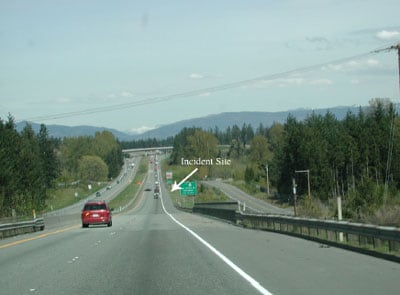
|
|
Photo 1. The view traveling down the highway east toward the incident site. The incident occurred at the bottom of the hill on the right shoulder.
|
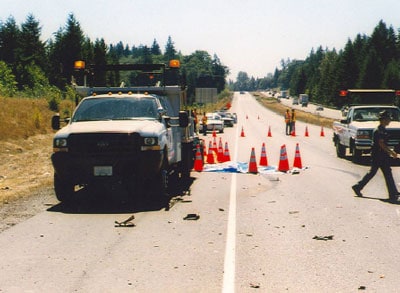
|
|
Photo 2. The incident scene after emergency response, facing west, looking up the hill toward on-coming traffic.
|
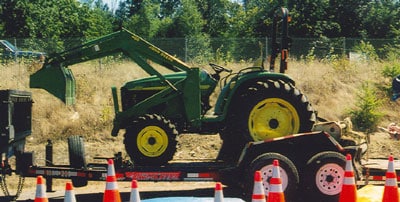
|
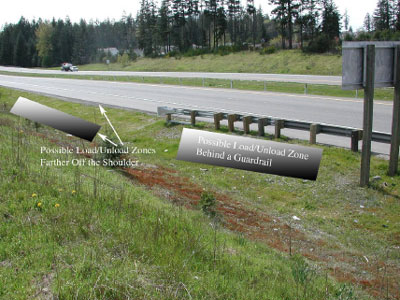
|
|
Photo 4. This figure shows several additional options, just beyond the site of the incident, for parking a trailer to load/unload that might provide better protection than the shoulder.
|
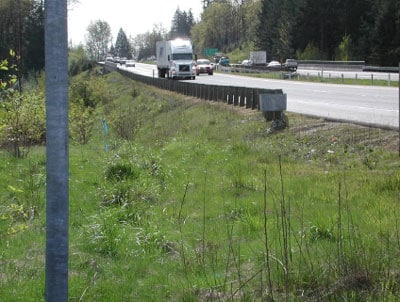
|
|
Photo 5. This photograph shows another possible site at the bottom of the hill, just before the incident site, where a trailer might be able to load/unload if feasible. This site would give good protection, behind a guardrail.
|
Washington FACE Program/SHARP
To contact Washington State FACE program personnel regarding State-based FACE reports, please use information listed on the Contact Sheet on the NIOSH FACE web site Please contact In-house FACE program personnel regarding In-house FACE reports and to gain assistance when State-FACE program personnel cannot be reached.

